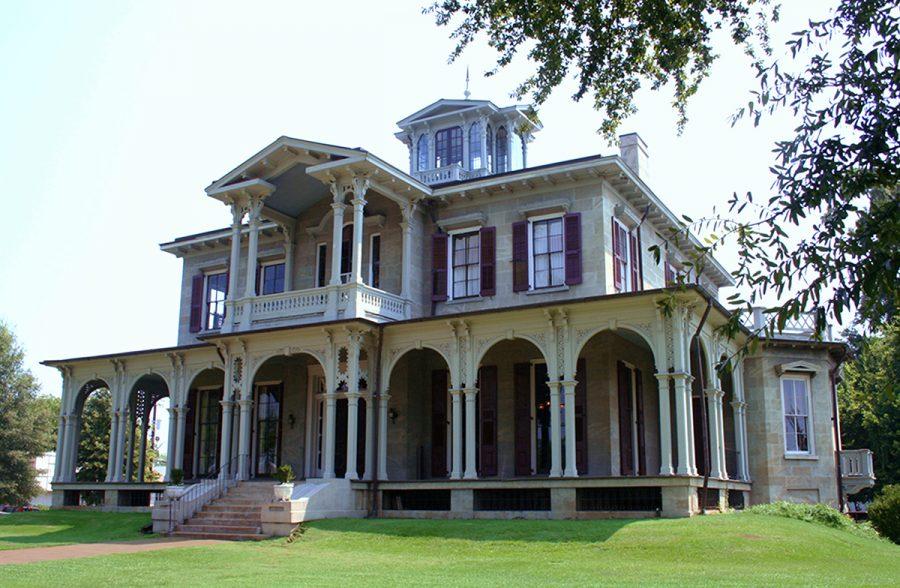During one of his early days working at the Jemison-Van de Graaff Mansion, Ian Crawford decided he was going to take advantage of the house’s circulation system. Built between 1859 and 1862, the mansion has it’s own circulation system built into the architecture. Vents at ground level pull cooler air into the underground basement and windows in a belvedere stationed at the top of the house pull the warmer air up and out.
By strategically opening and closing windows, the air flow current in the house can be manipulated throughout the day. Crawford decided to open the vents downstairs the doors on the first floor and the windows on the second. When he got up to the attic he said the air outside was cool but inside it was lukewarm. Then he opened the air vents at the top.
“It was just rushing, roaring air flowing out of the house and then I heard all these doors slam because of the pressure change and I was like ‘uh oh,’” said Crawford, the executive director of the Tuscaloosa County Preservation Society. “So I come downstairs and there’s papers everywhere. The brochures that were on the front table had all been blown. They were halfway up the staircase.”
Crawford has been working with the Jemison-Van de Graaff Mansion since 2011 after studying Interior Design at The University of Alabama and working toward his Master’s degree in Preservation Studies from Tulane. Now he works out of the basement of the mansion built by Alabama senator, Robert Jemison who was responsible for the construction of Bryce Hospital, built the first bridge over the Black Warrior River and rewrote the state’s tax code to create a system that could be used from 1837 to the 1970s.
“I think it is so important for people to actually get a, we’ll call it a hands-on experience,” Crawford said. “When it comes to these places, I see these houses as three-dimensional textbooks. These are sources of education, sources of learning, and there’s so much you can see and experience and feel when you actually go to the places. Standing in a room and saying this is where slaves worked, this is the kitchen where they would have done these things, this is where someone wrote the Declaration of Independence, this is where someone wrote a symphony, all the different things. There’s a power to that place.”
The original Jemison Mansion was staffed by slaves including a man named Alfred who was responsible for opening and closing the vents and windows to control the air circulation. The more they study the mansion’s history and find new family artifacts, Crawford said, the more detailed their stories become.
“They start out as a list, you know he owned this many people, and then later on you get a list with names and they become more and more integral to the story as you’re able to find more and more about them,” he said. “One of our best documents is Mrs. Jemison’s day book… there’s a couple places where she’s listing out what chores she’s giving to people and so we’re able to see what some of these enslaved people were being told to do during the day.”
Senior hospitality major Kimberly Crabbe has been working at the mansion since May. A self described history lover, Crabbe said working in the lower levels, she often forgets that she’s sitting below an antebellum home. Sometimes, she said, she goes upstairs to think and gets “kind of lost in it.”
“I like anything that kind of ties me to my roots and Alabama,” she said. “As much as Alabama’s history can be controversial, I still want to find the good things in it, the happy things in it and sometimes the scary things in it.”
One of her favorite figures connected to the house is Priscilla Cherokee Jemison, Senator Jemison’s wife. Before she was born, the family legend goes, her mother was saved by a Cherokee Chief in a Choctaw Indian raid. When they asked how they could repay him, he put his hand on Priscilla’s mother’s pregnant stomach and told her to name her children for his children.
When Priscilla and Robert Jemison had a daughter, they continued the tradition and named her Cherokee. She in turn named her daughter Minnie Cherokee. According to Crawford, there have been seven generations of Cherokee daughters.
“I think it’s good for everybody to get little backstories of what it’s like to live back in the Civil War,” Crabbe said. “We don’t know anymore. There’s really nobody left from that time to tell stories. It’s all passed down. We have to keep it going so people can hear those stories so we can be like ‘yeah there was a time where this was real and slaves weren’t seen and it existed and it wasn’t great but it existed and it still needs to be learned about.’”
Crabbe said working at the mansion has increased her appreciation for Tuscaloosa’s history and its connections to larger historical events. Her favorite piece in the mansion is a large floor to ceiling mirror given to the Jemison family by Jefferson Davis’ brother who sought refuge with the family during the Civil War.
“To think that in Tuscaloosa, that mirror is sitting there and probably nobody knows it’s here, that kind of thing is crazy to me,” she said. “There could be so many things spread across this town that nobody knows is there and it has just these huge stories behind them.”









